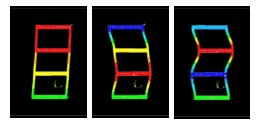Education fields (for undergraduate program)
We are responsible for professional education in graduate and undergraduate programs. Courses for instance include subjects as follows.
Mechanical Vibrations 1 and Exercise
Mechanical Vibrations II
Numerical Analysis and Programming Exercise
Ergonomics
Some materials for understanding vibration
Some vibration-related materials are provided as follows. They may help understand vibration phenomena and also the role of vibration engineering. Topics here include: dynamic vibration absorber, inverted pendulum, and the Chladni figure.
Mitigating vibrations using the dynamic vibration absorber
Resonance occurs when the frequency of forced excitation is at or very close to one of natural frequencies of a structure. The dynamic vibration absorber is a spring-mass system whose natural frequency is tuned to a specific frequency. The absorber is attached to the primary structure so that the secondary vibration system dissipates energy and thus reduces vibration in the primary mass.


Three absorbers are attached to each floor of the 3-DOF structure. The natural frequencies of absorbers are tuned to respective natural frequencies of the primary system.
| Near the 1st resonance | Near the 2nd resonance | Near the 3rd resonance |
Parametric inverted pendulum
By exciting pivot of the pendulum in vertical direction at high frequency (much higher than its natural frequency), the pendulum comes to rest at inverted posture. This is thought to be a kind of the parametric excitation phenomena.
Observation of vibration modes by the Chladni figure
Vibrating system usually has one or more natural frequencies and the corresponding vibration modes. The Chladni figure is a simple way to visualize vibration modes of vibrating object, specifically effective for thin elastic plates. By spreading sand evenly on vibrating plate, we can observe a modal pattern at a specific resonance.
| Square plate: 103Hz | Square plate: 264Hz | Square plate: 468Hz |
| Circular plate: 405Hz | Circular plate: 563Hz | Circular plate: 769Hz |
